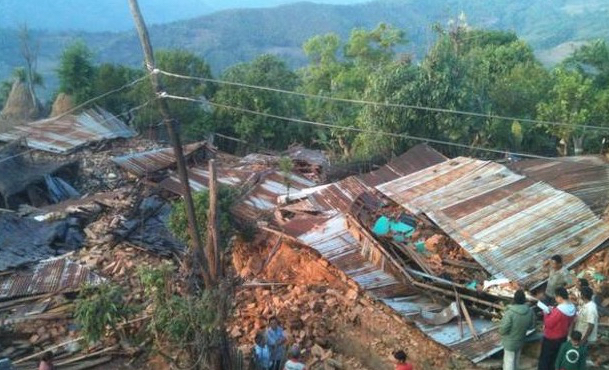Leaders and decision-makers are critical in times of crisis. We have been investing in leaders in Nepal for the past 10 years and we are hoping to be able to encourage and resource them as much as we can as they prayerfully step into relief work that few are prepared to do. As of today 5,000 are reported dead and estimates are that those numbers may rise to 10,000. Relief agencies are on the ground providing food, water, shelter, and medical help. But there is also a long term need of coming alongside leaders who will have the will and the ability to follow through on projects to help rebuild people’s lives.
If you are wanting to find a way to help, I’ve listed below a few resources that may be of interest if you know people in Nepal or just want to get involved…. (read more)…
IMMEDIATE RELIEF
To donate toward immediate relief, I recommend giving to Convoy of Hope. They have relationships with over 100 churches that will be resourced as sites to give out critical aid to those suffering from the Himalayan Earthquake:
It is because of our many networks and partners that we are able to respond immediately during a time of need,” says Kary Kingsland, senior vice president of Convoy of Hope. “We will continue to work diligently to bring help and hope to the survivors of this devastating earthquake in Nepal.
Here is the link to Give to Convoy of Hope.
LONGER-TERM RELIEF TO EMPOWER LEADERS IN THEIR EFFORTS TO ORGANIZE AND LEAD THE INDIGENOUS RESPONSE
I am headed to Nepal on Sunday, May 3rd to join with several pastors and leaders who I believe will provide long term leadership to the relief and rebuilding process in Nepal. I have known several of these men for 10 years and we are going to assess the situation with them and provide resources to them to visit affected areas with proper transportation as well as begin mapping out a plan for how churches that are less effected can serve those communities who were the hardest hit. If you would like to donate to our efforts there, we are trying to raise $25,000 by Friday, May 1st.
Please Give now to the Nepal Disaster Relief Fund with Nexus International.
LESSONS LEARNED FROM THE NEPAL HIMALAYAN EARTHQUAKE
Since we are focused on serving indigenous leaders we are gathering resources to help them lead. Already, a great resource has been written on lessons learned in Nepal. It compares to other earthquakes in very poor countries. If you would like to read this 2 page document here’s link: Lessons Learned from Nepal Earthquake. Written by ALNAP and ACAPS (Strengthening Humanitarian Action through Evaluation and Learning), they share lessons learned through analysis and evaluation of past earthquakes with similar characteristics as the one in Nepal.
LONG TERM ECONOMIC EFFECTS FOR CONSIDERATION
One of the things we have been working on for many years is the problem of keeping young Nepalese in the country to invest in their communities rather than leaving to go find work in other countries. As we develop youth work throughout the country we have heard from indigenous leaders that the greatest challenge to an expansion of youth work is providing sustainable jobs for the young to establish their lives and families so they can stick around to develop ongoing youth ministries. We have helped one group in Pokhara start a trekking company for this purpose: to provide jobs for youth workers. Several young leaders in youth ministry have been employed by Nepal Outdoor Adventures to guide treks in the tourist season, and then getting paid a good wage they have time in the off season to work in ministry. This earthquake will no doubt effect their business, so we would appreciate prayers for them as they try to re-establish the tourism sector because it provides alot of jobs. We are also working to start a few other micro-enterprises that could create more jobs, but it will take a few months to get back on track with this. To outline some of the economic effects below is a good summary.
Economic effects (from Wikipedia Himalayan Earthquake)
Nepal, with a total GDP of $19.921 billion (according to a 2012 estimate), is one of Asia’s poorest countries, and has little scope to fund a major reconstruction effort on its own.Even before the quake, the Asian Development Bank estimated that it needs to spend about four times more than it currently does annually on infrastructure through 2020 to attract investment.The U.S. Geological Survey initially estimated economic losses from the temblor at 9 percent to 50 percent of gross domestic product, with a best guess of 35 percent. “It’s too hard for now to tell the extent of the damage and the effect on Nepal’s GDP”, according to Hun Kim, an ADB (Asian Development Bank) official. The ADB said Monday it will provide a USD$3 million grant to Nepal for immediate relief efforts, and up to USD$200 million for the first phase of rehabilitation.
This is a very catastrophic event in a very poor nation. The cost of reconstruction over the next few years will be massive. Rebuilding costs could “easily exceed” USD$5 billion, which would be about 20 percent of Nepal’s gross domestic product”, said Rajiv Biswas, chief Asia economist at IHS (IHS Inc.)
Thank you for joining with us in prayer and support for the wonderful people of Nepal!

